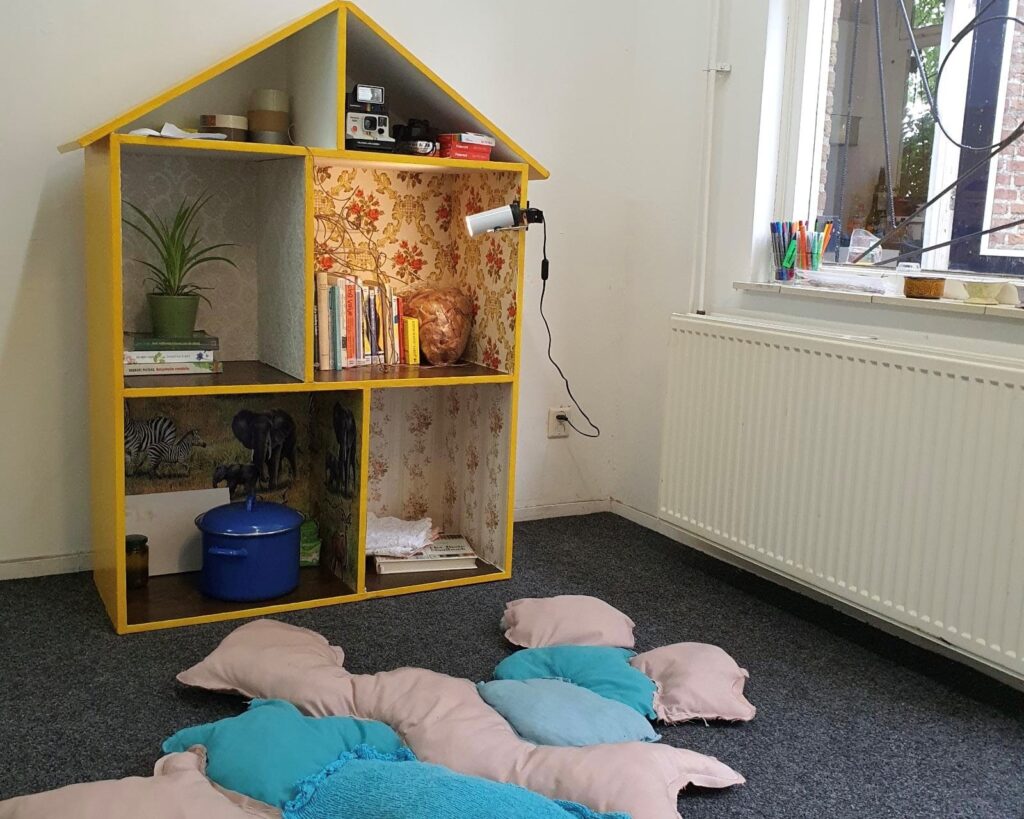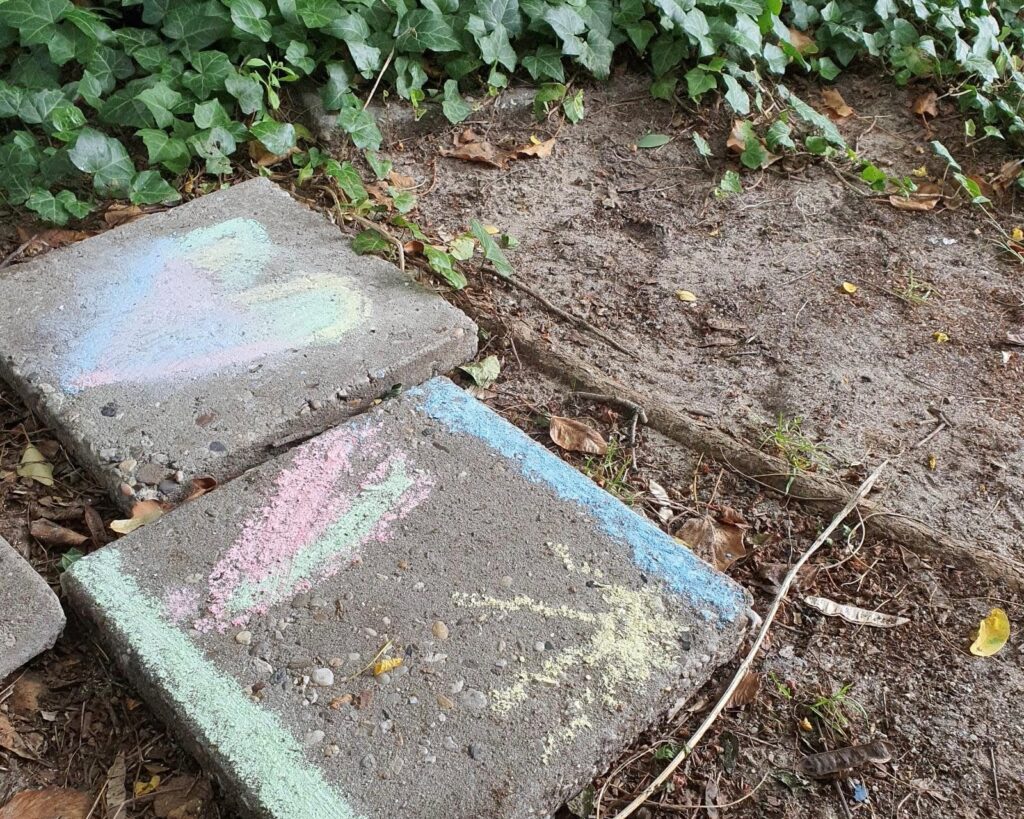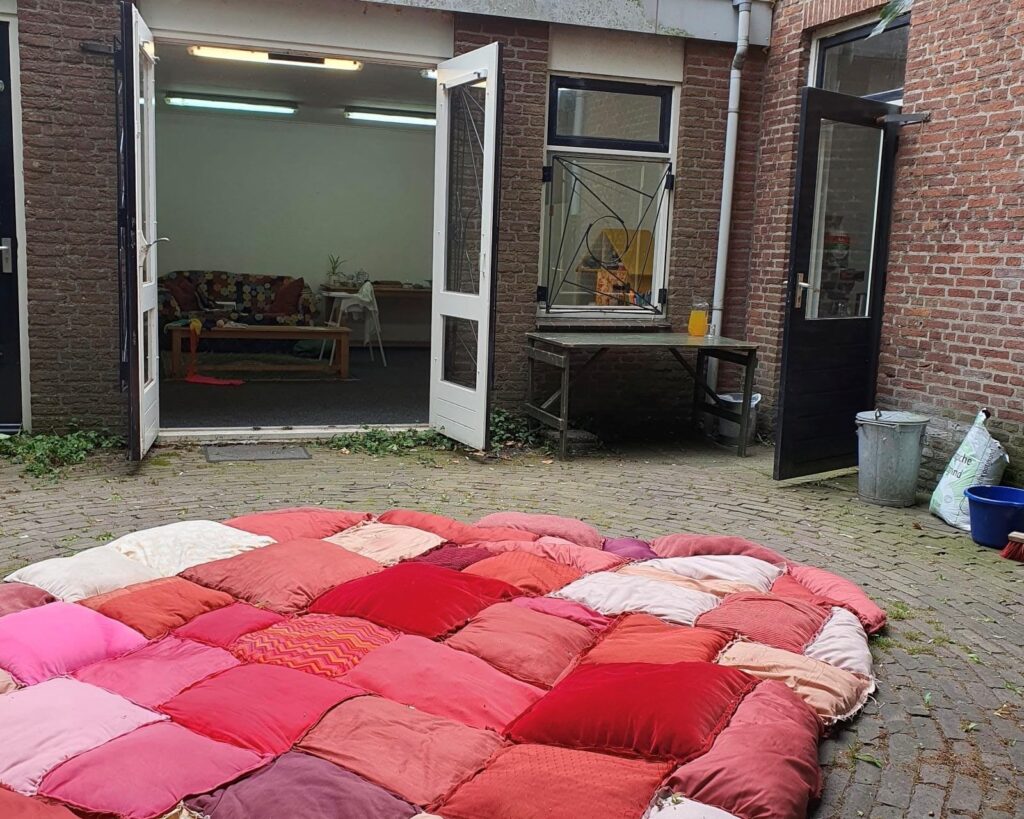 Agenda
Artikelen
Programma
Agenda
Artikelen
Programma

How do you approach a residency as an art research group? How can we take our values as Vrouwenmantel Art Research Group into the space and time offered to us by Witte Rook?
A care-based residency
We at Vrouwenmantel Art Research Group strive to create spaces where the maternal in art can be researched, such as the maternal that can be assumed in one’s art practice or the alternative models in art that are found on a care-based work ethic. In these spaces integrity, safety, inclusivity and caregiving are our main priorities and are in place to abolish hierarchical structures. Based on the values of Vrouwenmantel, we have decided to set up a temporary collective during the period from June 21 until July 12 2021. During this period Vrouwenmantel will consist of seven women who strive for a different model in the (art)world that provides room to be a mother/caregiver and who recognize the importance of a caring attitude.
In addition to these seven women, Kija’s son will also be present during the residency. Vrouwenmantel strives for an art practice in which a symbiosis can be formed with motherhood and therefore welcome, and encourage the mother to bring her child into a residency. We strive to create joint places where people can work and care at the same time. Where life with children is not separate from work spheres, but rather a space where the lines are blurred and an exploratory life is possible. This would allow a lot more room for the development of both mothers and children.
Caring can also be the opportunity to share your insecurities and desires, to be informally and personally involved with one another and to be able to explore within this openness how to support each other. Caring can take on substantive forms, by entering into a conversation about each other’s interests, brainstorming on furthering an idea, asking questions based on the desire to help the other, sharing knowledge. Care can also be given practical expression, for example, in offering to help the other in realizing their work. For Vrouwenmantel caring can be channeled in research. It offers space for the broadening of the process. The use of material can be a tool for connection and does not necessarily have to result in an (exhibitable) thesis. That being said, we are curious about the role documentation and residuals can take in investigative practices that are mainly immaterial and focused on social processes. The caring model can be to unite together as artists for a common interest or a shared approach. For example, by relating as a group to a certain place and the people who reside there, and respond to the care said place could be engaged in.
During this residency we do not strive for an end result and the concept of ‘achieving’ is not the end-all-be-all it is in the current art climate. The focus is to research a care-based work ethic, to determine which conditions it needs, and what it means to be a temporary collective in which caring is the baseline. It allows us to ask important questions such as: what do sisterhood and friendship mean? What elements are these relationships built on? How do our definitions of care differ? What does it mean to take on the role of motherhood (even if one is not actually a parent, but in intention they want to assume the role)? And how can art be a connecting role in everything? In this residency we have the opportunity to explore common caring values, use it to better our understanding of our own practices, while being in continuous connection with each other.

Hanne van Beek
I get my inspiration from my immediate environment. I am curious how I can get closer to somebody (through observation, documentation, conversation, entering into a shared experience). I am fascinated by the inner world of each person and the exclusive composition of details that makes each person unique.
On an individual level I would, later on in my life, like to support people in writing down their (life) stories. In addition, I am looking for ways in which collective intimacy can emerge. I wish to connect people.
My research currently consists of the creation, activation and preservation of memories.
The language I use in this research is investigative, archiving, performative and arranging.
During the residency at Witte Rook, I want to establish contact with the local residents in conjunction with Isa. I would like to enable different people and households to enter into (indirect) contact with each other in an accessible way. I want to write a neighborhood cookbook that contains recipes from several local residents. I want to ask people for recipes that evoke clear memories for them. I want to process the accompanying stories appropriately in the cookbook. One of the moments I would like.
One of the moments I would like to conduct the conversations about memories would be during the classes that Isa provides.
Isa Janssen
I would describe my art practice as one that moves between the ordinary and the art world. I like to keep my audience small and intimate. This means that my audience can be the family that take a class provided by me. Participant of the work and at the same time audience/spectator. For a number of months I have been developing and implementing a concept in which I give workshops to families. During the workshop, the family makes a china set out of clay, which they can then continue to use at home. This idea stems from research on expressions of gratitude. I think you appreciate food on your plate when the dishes are handmade. What moments will be fondly remembered by a family while using homemade china . I look for connection during the process and hope that this will be maintained during the use of the completed set.
I want to develope this concept further during the residency, this in conjunction with Hanne. I want to invite a local family / families to participate in a class provided by me, where together they can learn and make their own china. At Witte Rook I want to try out this workshop on a larger scale, in different context and in a new space. Hanne has an idea that fits nicely with this, hence the collaboration.

Femke van Heijningen
In my art practice I question how one as an artist can ask responsibility for each other’s practice. I like to create and work with my fellow artists. By organizing workshops and happenings and recording conversations I conduct my research. Transferring knowledge and taking care of each other as a person is fundamental.
I also make ceramic objects. These bowl-shaped objects are representations of my Utopian imagination of the world. I would like to see if my ceramic works can be given a place during the residency. as an object for use or showing it as a piece.
Fien Onderwater
I want to create environments which hold room for playfulness, curiosity, spontaneity and a sense of freedom.
I’ve always been stubborn about my freedom. I want to discover in a playful way, and most importantly in my own way, both during the making and during the experience. I want to be able to take my time in making, on hand this means making without purposelessly, but with attention through meditative or repetitive actions. But on the other hand, it can also be wonderful to rush by sewing with large wild stitches, or ragging the fabrics through the sewing machine at a great speed. I want to be able to call it laziness, when it is just that: laziness. Not feeling forced to pretend that all choices are intentional. I want to adapt the way I work, write and speak to what I need at that moment. Sometimes I have the feeling that there is no room these things, that you are only taken seriously when you speak in “artist’s language and work according to the prevailing standards of success and competition”.
At Witte Rook, I want to investigate how we can show that working and relaxing, and caring and giving criticism are not at odds with each other, but are two sides of the same coin and reinforce each other.

Danielle Verschuren
I feel the necessity of making, of understanding what it means to create. It’s trying to make an understanding of the soft, the pleasant, the tangible. AN invitation to touch, to feel, to discuss. To sound out syllables until words form. Words to describe touch, while I softly press this into your hands, gently asking you to receive. What is yours and what is mine?
My process starts out of curiosity, a way to breathe life into the questions that leave my mouth. Curling around the words that feel soft, so they can feel soft out here too. It’s a way to find my place in the world. To share, to let others touch upon what I learned.
Making where I am, being where I make. Inkt starts running when wet, the sea erases lines in the sand. At home I make, though I am a homemaker. The creation of a small universe, formed of my likeness. Made out of knowledge, made out of being known, made of being safe.
Jolijn Durinck
I want to spend my time at Witte Rook “being” there. This ‘being’ there is based on certain bits of information. The location, facilities and people will largely determine what will take place. The list of things I bring with me will also be decisive. This is my list:
– Large soup pot
– Seeds
– Garden tools
– Onion peels
– Lady’s Mantle Tea
– Fabric and craft supplies
– Sewing machine
– Books (Vrouwenmantel Archive and more)
– Photo camera
– Phone
– Laptop
– Money
– Overnightbag ( to be completed even further)
Another bit of information is that I want to stay the night at Witte Rook. By staying the night there, I can really connect with the place. I get my groceries for dinner from the shops around the corner and my breakfast from the bakery around the corner. Despite the fact that my own place of residence is a few around the corners away, staying over seems to be an important part of “being”. I will therefore approach my house in a different way. It is a place where I can go to, for example, pick up material, where I come to stay overnight and where I go to water the plants.
What is the intention of this specific residency? What are the interests? How do you keep those clear?
‘Being’ as a whole is a way of caring.
Kija Benford
Before my art practice used to be a walking practice in which I went on walks alone or with participants. During these walks, connecting with the environment and with the people with whom you share this environment with was integral.
However, due to my motherhood and the confrontation with the taboo surrounding motherhood in art, a shift has arisen in my practice therefore me and Jolijn Durinck, have started to focus on creating a space in which motherhood and care-based models in art can be explored. Vrouwenmantel Art Research Group was born from this research.
From this point onwards I started to focus on writing essays and articles about motherhood in art. My role within Vrouwenmantel is conducting textual and visual research, social media management and the organizational tasks surrounding Vrouwenmantel.
During the residency at Witte Rook, I will, as I am in day-to-day life, be a mother and take care of my son. In addition, I want to investigate the extence of my role as a mother and whether or not I can translate this role into actions, within the space of Witte Rook, and in the communication with the people whom I share this space with.
Furthermore, I will conduct a textual and visual research into my motherhood and art practice in which my daily life with my son in the residency at Witte Rook will serve as a starting point.